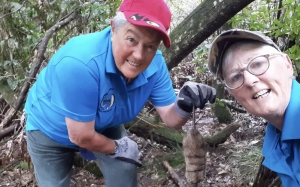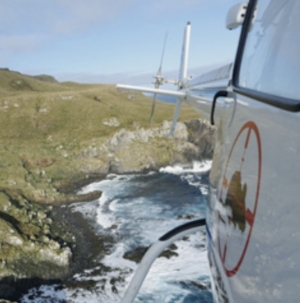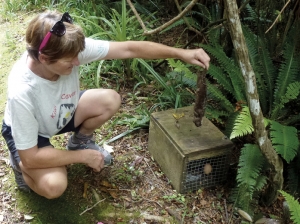Displaying items by tag: Pest eradication
Gone fishin' and trapping
The number of whio in the Tongariro catchment is growing, thanks to a recovery plan run by the Department
of Conservation from 2009 to 2019 and groups of volunteers who monitor hundreds of traps in the region.
Two Taupō Fishing Club members and dedicated trappers Chris Pritt – the sister of DU Patron Di Pritt – and Lesley Hosking are been doing their bit on the upper reaches of the Hinemaiaia River. Lesley says, "We have trapped mostly rats and other predators on the upper Hinemaiaia River for more than two years, starting in August 2018 with only eight trap stations. We now check 42 traps every week – these are 36 box traps with DOC 200 trap mechanisms and 8 Goodnature A12 or A24 gas operated traps.
"We took over this part of the river to assist and free up David Cade (aka Didymo Dave) who started the trapping with the aim of getting the native birdlife to flourish again. He now traps further upstream on a regular basis while we patrol the well-worn fishing tracks and three car parks."
Didymo Dave has been trapping on the Hinemaiaia for 10 years and in 2019 caught his 1000th rat. "To date we have trapped 328 predators which include hundreds of rats and mice, four weasels, two stoats, and one possum, which was in the DOC 200 trap," Lesley says.
Pic's Peanut Butter is their bait of choice and they use about 5kg every six weeks. The peanut butter is waste from the Pic's factory which sells it at a reduced price on the Predator Free website. It is not edible as it has a greenish additive.
"By trapping so rigorously, we now have the reward of seeing North Island robin, tomtits, kereru, fantails, tui, bellbirds, whiteheads, and two whio have moved in near Car Park 3; we hope they will mate and there will be more whio. The pair seem overly friendly and we think perhaps they have originated from the Tūrangi whio raising enclosure," Lesley says.
Lesley and Chris are unsure if the whio nested this season but say they have taken up residence on the far side of the river where there are no fishing tracks.
The Taupō Fishing Club originally became involved in vermin trapping because its members were sick of rats chewing newly caught trout laid out on the riverbank while they continued fishing.
The two women fish two or three days a week on Flaxy Lakes, the Tongariro River and river delta, Waimarino River mouth, and in summer, they boat fish on Lake Taupō.
In January, their volunteer work was nationally recognised by the New Zealand Sports Fishing Council which awarded Lesley and Chris its 2020 Volunteers of the Year award.
As well as their trapping work, the pair worked together to save the Taupō Fishing Club when it was facing physical, financial and administrative collapse.
Club president Shirley Fraser says, “Our clubrooms were in desperate need of maintenance after having been neglected for years. Extensive rat damage had resulted in major water damage."
The building was collapsing and needed repainting, the roof needed repairing and guttering, wiring, and plumbing needed replacing.
“Not only did they do much of the prep work, painting, cleaning and so on, they organised quotes, oversaw the tradesmen and brought the project in under budget. Now the rooms are a pleasure to call ours.”
Lesley and Chris also took on the job of implementing a new administration system and overhauling the club finances and reporting systems.
Ferret lured by sardine juice
The ferret must have liked the smell of the juice from the ‘Sardines in Springwater’. Note the colour of the ferret, mostly white.
Another hedgehog trap used, DO 200 (pic right). Blackbirds use the top of the trap to crack the snail shells on. It is awash of snail ‘juice’, for the want of a better word, and the trap is surrounded by empty snail shells, sometimes this activity sets the trap off.
Keep alert – invaders are everywhere
Keep alert – invaders are everywhere
No 1: Velvertleaf.
As of Wednesday April 20, Velvetleaf had been confirmed on 196 properties in 11 regions of New Zealand. This number is expected to increase as the Ministry for Primary Industries (MPI) continue to visit properties in Otago and Southland known to have planted the Kyros or Bangor fodder beet varieties.
More and more unwanted problems and pests are invading out lovely country. We need to be alert and make sure caring people like Ducks Unlimited members keep a look out for problems.
Velvetleaf is one of the world’s worst cropping weeds and it is just about everywhere fodder beet has been planted this season.
Velvertleaf is an annual board leafed herb that grows up to 2.5m tall. It has large heart shaped leaves, velverty to the touch. It flowers from spring through to autumn with yellow flowers about 3cm across.
It crows in crops, if you think it might be on your place contact Ministry for Primary Industries (MPI) 0800 08 99 66. Advice it not to pull up the plants but contact MPI.
No 2: Honeybees.
Our little helpers are in danger of memory deficits and learning. Even low levels of pesticide can harm the bees. It means they lose the ability to recall odours and worse they lose their odour-learning abilities.
Bees rely on memory to target flowers, but exposure to various sprays appears to be stunting their effectiveness as nectar foragers and pollinators.
Researchers at Otago University tested bees from 51 hives at 17 sites in Otago and tested their pesticide chlorphyrifos levels. Low levels of the pesticide were found in bees at three ofthe sites.
In 2013 the team from Otago’s Department of Chemistry showed chlorpyrifos was detectable in air, water and plant samples, and even in non-sprayed areas as it had a high ability to volatilise and travel great distances.
Most uses of the chemical have been banned in Britain since April 1 this year.
No 3: Blackgrass.
Now there is Blackgrass. It was detected during routine sampling of rye grass seed in Canterbury in February.
It seems to be an isolated incident, but farmers should stay alert and are urged that a thorough investigation should be undertaken to trace all potentially contaminated material.
Blackgrass is an invasive plant that is difficult to contain once it spreads. It competes with winter crops for light, nutrients, space and water, resulting in yield loss and increased cultivation costs that could be potentially devastating to the New Zealand Arable Industry.
Whio in the spotlight
With less than 3000 whio around New Zealand, they need all the help they can get.
A two-day Whio Recovery Workshop was held in June at Tokaanu, near Turangi, where people with a passion for the endangered nativeblue duck gathered to hear information, ask questions and get what answers they could, although the overwhelming conclusion was that there is still lots more to be done.
More than 50 people involved in whio protection in the North Island took part in the workshop, which was held at the Genesis Energy Tokaanu Power Station.
The attendees were able to grow and maintain links with like-minded people, share their skills, learn more about research and consider some of the innovations being tried to ensure the safety of whio and increase its numbers. That included new and better ways to keep predators away and, if possible, eliminate themwith best practice monitoring and trapping techniques.
The workshop group also visited the Turangi Trout Fishery, where they were shown how to set and use predator traps and how to set nets to catch ducks.
The recovery programme involves not only paid workers, but private organisations and volunteers. They give up their own time to set traps, walk trap lines every two to three weeks,and keep an eye on the ducks at the same time.
This workshop was not just a talkfest, but included the chance to learn about the latest research and tools, and take part in practical demonstrations such as trap maintenance and safety.
Threats to whio
Introduced predators are the whio’s worst enemies. A whio recovery plan includes trapping and the use of toxins to reduced predators. Without such work, there would be no whio.
Stoats are the main killers, along with ferrets, feral cats, falcons and dogs. But events such as floods, that scour out riverbanks, can take away the whio’s food source. Even resource consents, water use and discharge of dirty water are a threat. Then, for the females, their moulting phase makes them vunerable to predators, as they cannot fly away.
The recovery project, without which the whio would be gone, is expensive and a significant partner is a necessity. Genesis Energy has stepped in to provide funding - $2 million overfive years - and its staff have become involvedin helping with recovery projects.
In the early 1980s, the Moawhango Tunnel was commissioned in the upper Tongariro River and whio numbers decreased in that area because of the changed flow volumes of the river. By 2004, however, work was done to create a minimum flow and the population rebounded.
Predation remains the key risk
Around the country, both Government workers and volunteers continue to trap predators and take care of eggs. Floods can wipe out a whole season’s ducklings. There is also a need to increase gender diversity and the transfer of juveniles to other areas helps with this.
Recent use of DOC200 traps and double set traps (where two predators are caught in the same trap), along with aerial 1080 drops, have helped survival. David Rogerson reported setting 85 traps and catching 50 rats a fortnight along the Maramataha River in the King Country. Malcolm Swanney trained Fern, a German short-haired pointer dog, to become a champion whio finder who will never hurt a bird.
The Ruahine Ranges
Janet Wilson, a keen tramper from the Manawatu, started work as a DOC volunteer trapper in 2011 in the Ruahines.
The Ruahine Whio Protection Trust was formed as a collective and now a strong group of volunteers works along120 kilometres of the range. Many drive to Napier and work the Napier ridge to the Orva and back south. There are 1500 traps and it is steep terrain.
Wellington Tramping and Mountaineering Club volunteers drive to Hawke’s Bay once a month to check and manage traps from that side.
Janet said she was disappointed that not enough protection work was done by DOC. Along those ranges there were 60 huts, mostly old. There are 500 plus tracks, and lots of rivers. “We have seven groups working together as a collective and using DOC200 traps.”
Jessica Scrimgeour said Janet and the collective have worked hard to keep the system going. “Janet’s commitment has driven the plan over the years.”
Taranaki trial
A trial whio recovery plan was put in place during 1999-2000 in Taranaki to investigate a viable population. Fifteen birds were introduced, but, for a variety of reasons, did not survive. The group persevered with stoat control in 2002 and in 2008, they released 170 ducks, with a 50-50 gender balance.
Between 2011 and 2016, the number of pairs has been good with a survival rate of about 81 percent. The next phase is to increase gender diversity. Predator control remains essential, but it was also found that it is best to transfer juveniles and not adults to other areas.
Some New Zealand Deer Stalkers Association members have agreed to help out by checking traps while out hunting.
Tongariro
Rachel Abbot talked about the Kia Whariti biodiversity project, which also involves DOC and Genesis Energy, in the 20,000-hectare Tongariro forest, bordered by the Whakapapa, Whanganui and Mangatepopo rivers, where they are using DOC 200 traps plus double set traps, and aerial 1080 drops. Since 2007, trapping has been in progress with 700 traps along the trap line.
Future threats
Another possible threat to whio is plantation forestry logging. However, recent information suggests that forestry companies who are aware of the presence of ducks will move their operations away from any nesting sites until the chicks have left.
The Whio Workshop was a success, but there’s such a lot to do, so let’s hope it will lead to more protection for the lovely whio. Alison Beath, the convenor, a senior ranger with DOC, is to be congratulated on the event.
Million Dollar Mouse pest drops completed
The ambitious Million Dollar Mouse pest eradication project on remote Antipodes Island in the sub-antarctic was completed ahead of schedule in July.
A second helicopter drop of rodent bait across the island was finished in July, following a first phase completed on June 29.
“Despite very unsettled weather conditions, the Million Dollar Mouse team have done an outstanding job of making use of every available weather window to get the bait drop completed,” Ms Barry, Minister of Conservation said.
“This is the most challenging pest eradication ever carried out in New Zealand and is a globally significant conservation achievement, safeguarding a unique, remote and forbidding land and the many extraordinary species living there.”
Mice are the only introduced predator on the island, which is home to endemic species such as the Reischek’s and Antipodes Island parakeets, snipe and pipit, thousands of seabirds and marine mammals.
“The second bait drop by mid-July is a major step on the way to returning Antipodes to the way it was before the arrival of humans, pests and weeds.
Million Dollar Mouse was jointly funded by DOC, the Morgan Foundation, Island Conservation, WWF-New Zealand and public donations.
Total eradication of mice cannot be confirmed until a monitoring team visit the island in 2018.
To find out more, visit the Million Dollar Mouse website
Protecting Whio
Keen predator hunter protecting Whio
The Ruahine Whio Protection Trust (RWPT) is a registered charity formed in late 2014 and functions though the efforts of a small group enthusiastically lead by chairwoman Janet Wilson. Its purpose is to raise funds to help protect and raise the number of Whio in the Ruahines and surrounds.
Janet has tramped for years in the Ruahines as a member of the Palmerston North Tramping and Mountaineering Club (PNTMC), and whio are often spotted on the river. Although being a protector of whio was not Janet’s original ambition, she took the opportunity to become a protector of the whio living and trying to survive in the area. Janet took over the running of the Oroua Valley Blue Duck Protection project from the NZDA (Manawatu Branch) in 2011. This expanded in to the Pohangina River in 2012.
“Life hasn’t been the same since,” said Janet. Trapping began in the Ruahines in 2007. Several groups now look after approx 1800 predator traps, predominantly DOC 200’s. These range from the Aorangi–Awarua Trust’s lands in the North to the Pohangina River in the South. In 2015 a Ruahine Whio Management Plan was developed by these groups with support from DOC, and along with the RWPT, they now make up what is known as the Ruahine Whio Protectors Collective.
Janet still coordinates the Oroua and Pohangina projects. Between July 2015 and June 2016, 110 stoats and weasels were caught, as well as 450 rats. She has a good team of willing volunteers but is always keen to hear from experienced trampers and hunters who might like to help out the whio. For many a tramp in the bush is no longer just a Sunday outing. It has become an ongoing war against the stoats, weasels, rats, and any other likely whio enemy.
Whio are the most endangered bird in the Manawatu and Janet is keen to raise the profile of our $10 duck locally. Janet said the Oroua and Pohangina rivers have the most southern population in the North Island. There are no known whio in the in the Tararua and Rimutaka ranges.



